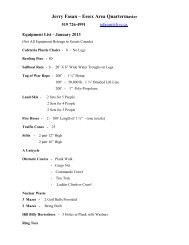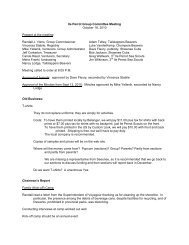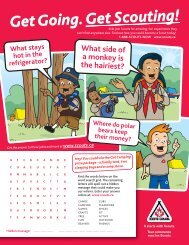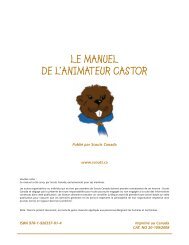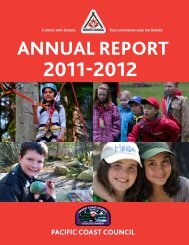Beaver Leader's Handbook - Scouts Canada
Beaver Leader's Handbook - Scouts Canada
Beaver Leader's Handbook - Scouts Canada
Create successful ePaper yourself
Turn your PDF publications into a flip-book with our unique Google optimized e-Paper software.
GROWTH AND DEVELOPMENT CHARACTERISTICS OF BEAVERS<br />
Physical Growth<br />
At this stage in life, a <strong>Beaver</strong>’s body does not grow at a fixed speed. Instead, there will be periods<br />
of slow and steady growth followed by rapid growth spurts. As a result, a <strong>Beaver</strong> whose<br />
movements were stable and comfortable may begin feeling awkward and uncoordinated.<br />
Your <strong>Beaver</strong>s’ large muscles are stronger and more highly developed than their fine muscles,<br />
such as fingers. As children mature, their smaller bones and fine muscle control become more<br />
developed, giving them more precise coordination and dexterity.<br />
The <strong>Beaver</strong>s’ five senses are almost completely developed and are beginning to work together.<br />
This, with their improving ability to handle objects, enables children to perceive and explore<br />
their world better.<br />
<strong>Beaver</strong>s have high energy levels and are good starters. However, they can tire easily and may<br />
not always be interested in completing a task.<br />
Mental Growth<br />
At this stage, children gather information through direct<br />
physical contact. <strong>Beaver</strong>s need and take great pleasure in<br />
handling objects: weighing, touching, turning, and placing<br />
them. They are very sensitive to shapes and colours,<br />
and fascinated by motion.<br />
<strong>Beaver</strong>s have a limited ability to concentrate. They need variety, change and movement from<br />
one activity to another. They also have limited ability to project in time. They see everything in<br />
concrete terms. This means that planning is beyond the mental grasp of <strong>Beaver</strong>-aged children.<br />
The vocabulary of <strong>Beaver</strong>s is still expanding. Often, although they are clear about the meaning<br />
of their words, their listeners may not be. <strong>Beaver</strong>s have a strong desire to improve their language<br />
skills, and love to listen to stories, sing songs and recount activities. Through language,<br />
children can ask “how” and “why” questions about their world.<br />
It’s at this stage that their perception of relationships begins to evolve. They start to understand<br />
cause and effect, and realize that actions have consequences.<br />
Up to age 10 to 12, children have not fully developed their values or moral reasoning. They look<br />
to adults for active examples of what is right and wrong. Since <strong>Beaver</strong>s learn much by watching<br />
what you do and repetition, you can help them develop good values through activities such<br />
as repeating the <strong>Beaver</strong> Promise and Law every week, role modelling, sharing, and treating all<br />
people equally and fairly.<br />
Social Growth<br />
<strong>Beaver</strong>s have a natural desire to play with friends. They’re becoming less self-centred and more<br />
interested in others. You can encourage them to share, take turns, and participate in colony or<br />
lodge activities. But <strong>Beaver</strong>s can also be impatient if they find they have to wait long.<br />
Children of this age need ongoing recognition and reinforcement for their participation in<br />
activities. It’s important to show them your appreciation or disapproval. Such reinforcement<br />
often enables them to carry on with something that interests them.<br />
Routines and structure are important to <strong>Beaver</strong>s. They provide a clear beginning and end to<br />
activities and security through familiarity. <strong>Beaver</strong>s need to know what is expected of them in<br />
simple language. They develop a healthy self image through successfully completing routines.<br />
6-1



